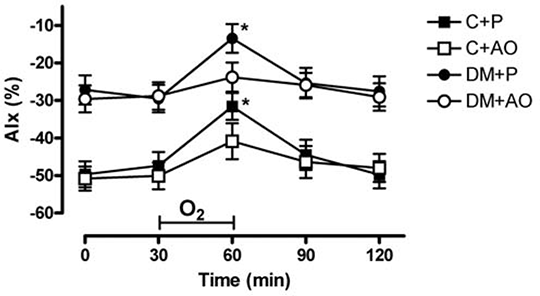Print version
Search Pub Med
Comparison of acute effects of antioxidants against hyperoxia-induced increase in arterial stiffness in healthy humans and in type 2 diabetics
Type 2 diabetics are more susceptible to both oxidative stress and atherosclerosis in comparison to healthy people, which could lead to increased risk for myocardial infarction. Oxygen is routinely used for therapy of myocardial infection, without any knowledge of oxyhaemoglobin saturation, which could result in hyperoxia. Hyperoxia causes vasoconstriction and acutely increases arterial stiffness (1), allegedly due to elevated oxidative stress – induced reduction of plasma nitrite (2). The aim of this study was to determine and compare acute effects of antioxidants on oxygen-induced increase in arterial stiffness in healthy humans and in type 2 diabetics. Ten healthy males, C, and ten male type 2 diabetics, DM, randomly consumed either placebo, P, or an oral antioxidant cocktail (vitamin C, 1000 mg; vitamin E, 600 IU; alpha-lipoic acid, 600 mg), AO. Every therapy was consumed once, a week apart, in a cross-over design, 30 minutes before the experiment. The volunteers breathed 100% normobaric O2 between 30th and 60th min of 2-h study protocol. Plasma levels of lipid peroxides and vitamin C, arterial stiffness (indicated by augmentation index, AIx) and arterial oxygen (PtcO2) pressure were measured at 1st, 30th, 60th, 90th and 120th minute of the study. Breathing of normobaric 100% oxygen during 30 min caused a similar increase of PtcO2 in all four experimental groups, confirming comparable exposure to hyperoxia. Vitamin C increased in two experimental groups receiving antioxidant cocktail (C+AO, DM+AO), suggesting successful application of antioxidants. AIx was markedly increased in diabetics, in comparison to healthy control, during the whole experiment. Exposure to oxygen resulted in increased AIx in all groups. However, antioxidants significantly reduced the increase of AIx in both diabetics and control (Fig. 1). 
In summary, antioxidants reduced the hyperoxia-induced increase in arterial stiffness in both healthy humans and in type 2 diabetics. Further studies, regarding potential beneficial effects of prophylactic application of antioxidants with oxygen, in high-risk patients - like diabetics, are warranted. (1) Krnic M, Modun D, Budimir D et al. (2011) Atherosclerosis 218: 530-535. (2) Modun D, Krnic M, Vukovic J et al. (2012) Clin Physiol Funct Imaging 32: 404-408.
|


 Figure 1. Changes in peripheral augmentation index (AIx). * p<0.05 Placebo vs. Antioxidants.
Figure 1. Changes in peripheral augmentation index (AIx). * p<0.05 Placebo vs. Antioxidants.